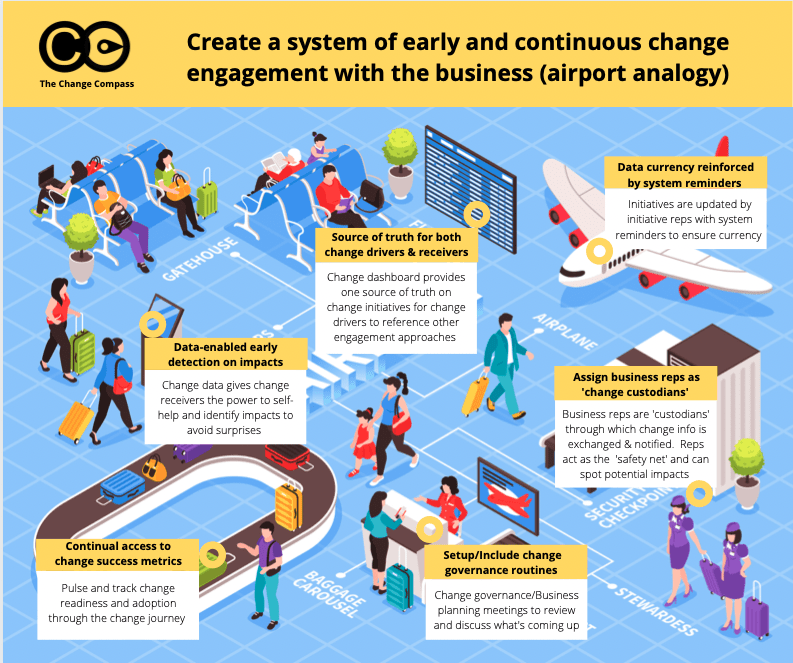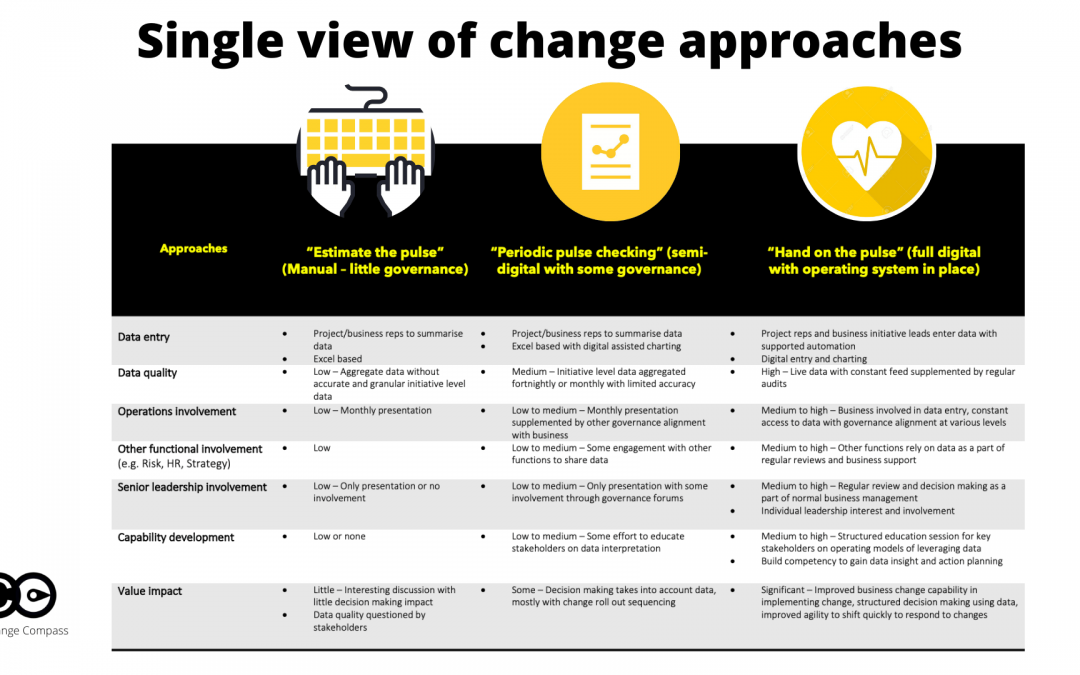
by The Change Compass | Designing change
Ever since the epidemic began people have started to suffer mental health issues. In fact, according to Harvard Business Review, recent studies have shown that 42% of employees globally have experienced a decline in mental health since the commencement of Covid. This is not a surprise given that governments have routinely locked-down populations to ensure safety and contain the spread of the virus. For change practitioners driving change initiatives within this context, it is hard to ignore these facts.
However, a lot of change practitioners are advised to steer clear of any mental health issues since they are not health practitioners and not qualified to deal with mental health issues. This may be true. However, just because change practitioners cannot advise on dealing with individuals with mental health issues, this does not mean that their approaches cannot take mental health into consideration. In fact, if a significant portion of the employee population have experienced reduced mental health, this needs to be taken into account and not ignored. Ignoring the facts can mean unsuccessful change outcomes.
So how can change practitioners take into account mental health issues affecting employees so that they are still able to drive successful initiatives?
Common mental health issues
Firstly, let’s look closer at common mental health issues impacting employees during the pandemic.
Anxiety and Depression
A recent report found that a quarter of 10-24-year-olds in the United States (Centers for Disease Control and Prevention) said that they had seriously considered suicide. Other surveys consistently show significant increases in anxiety and depressive disorders and correspond with pandemic trends.
Symptoms of anxiety can range from insomnia, panic attacks, feeling of apprehension, or impending doom, and breathlessness. Anxiety symptoms can also be less physically pronounced such as sweating, dry mouth, dizziness, nausea, difficulty concentrating, and irritability. Symptoms of depression can include difficulty finding joy and difficulty in engaging in normal activities, low energy, declined appetite, hopelessness, and that everything seems an effort.
Languishing
For a section of the population, it may be that they are not feeling severe enough to be diagnosed as being depressed or anxious in a clinical sense. However, it does not mean that their mental health states are optimal. The New York Times labelled this ‘feeling blah’ as ‘languishing’ and that it could be the dominant emotion of 2021. Languishing is the in-between level of the optimal level of mental health and suffering from mental health illness.
People were not feeling burnt out of depressed per se. However, there’s less of the usual excitement, hope and joy in their usual daily lives. Recently I visited my medical practitioner and he commented that of his patients most are suffering various medical conditions and that there are definitely a lot more reports of mental health concerns. People who experience this may not even report it nor even notice it. First comes fewer social interactions, then comes increasing solitude and even isolation.
Incorporating mental health concerns in change delivery tactics
Acknowledgement
The first step to take in incorporating people’s mental health concerns in change delivery is to openly acknowledge this. A lot of corporate communications functions would much prefer to not touch anything that is even remotely negative. However, acknowledging what people are going through builds trust and connection. Ignoring the elephant in the room will not help to engage employees. It is not that this needs to be the front-and-centre of the communication messaging. However, mentioning that there may be employees suffering from mental health issues can be the first step in building improved connections and confront the stigma.
This is especially important if you are driving an initiative that will have a significant impact on employees. If you are requiring employees to undergo significant impact whilst they may be battling with mental health issues, then addressing it head-on is critical.
Role model and sharing of experiences
The initiative sponsor and various change champions can be leveraged to share their personal experiences in dealing with mental health concerns. This helps to de-stigmatize mental health in the workplace and open up the discussion of people’s challenges. During forums, town halls, or even in articles or newsletters, the sponsor can share his/her own experiences in dealing with mental health issues. The trick is to be candid and open. This helps to foster trust with the employees.
Picking up on cues when engaging with individual stakeholders
When working with various stakeholders it helps to establish routine of ‘checking-in’ to sense-check the mental status of everyone prior to starting the meeting. This helps to level-set everyone’s mental status prior to diving into work discussions and helps everyone to understand how others are doing, thereby creating connectivity and inclusiveness.
If you pick up particular cues that the stakeholder may be suffering from mental health issues check-in individually with them to see if they are doing ok. Then, connect them to any company resources available such as employee assistance programs.
Map out the initiatives that impact them – prioritise and sequence.
Mapping out the various initiatives that impact the stakeholder group is one of the most strategic tactics in this list. It means taking an end-user perspective and plotting out all the various initiatives and changes that impact them. Taking this end-user, and design thinking approach, we are not just concerned about the particular initiative that we are driving, but all the various initiatives that the person is/will be experiencing.
During times of change fatigue, it may be that proactive intervention may be required to better prioritise and sequence the change rollout to manage the capacity of the impacted stakeholders. To read up on how to do this refer to the following article:
The Ultimate Guide to Change Portfolio Management
Segment employees to understand differing needs.
Different employee groups may be experiencing different needs and challenges. Those with children and that are dealing with childcare challenges during the working day may be experiencing different mental health challenges than those who are singles. Singles may be more inclined to feel isolated and disconnected with limited social support.
By creating different segments, you can position communication messages to better target those audience groups. These are some ideas of potential change tactics for different employee groups:
- Employees with children and/or dependents – Offering flexibility in selecting time slots for training sessions, or record any town hall sessions in case they were interrupted during the session
- Fully remote workers – Scheduling engagement sessions that involve facilitated discussions on personal experiences in the broader sense beyond just the initiative itself
- Non-remote workers – Organising virtual sessions for non-remote workers to connect with remote workers to foster greater connection
- Managers – Organise engagement sessions with managers that include content on dealing with employees on mental health issues as a part of the overall manager engagement session content
Measure
As a part of the overall change tactic of successfully implementing the initiative, it makes sense to measure and track employee sentiments. A typical change readiness assessment survey may be supplemented by items on employee mental health. This will help to proactively assess the extent of the mental health challenge for employees and how they may impact the extent to which the initiative could be successful. Survey findings may be socialised with leaders to derive subsequent strategies to tackle the issues.
Surveys do not need to be long and exhaustive. A common digital practice for applications is short, and sharp pulse ratings that only have a few items. Having frequent pulse surveys also helps to assess the development of the issues at hand and to what extent employee sentiments are as anticipated.
To read up more about measuring change visit The Ultimate Guide to Measuring Change.

by The Change Compass | Change Initiatives
You know the drill …. having been around the blocks and worked on many projects you’ve seen these many times over. Change managers often go through similar experiences as we progress through each phase of the project.
What has been your experiences across the various project that you’ve worked on? What are some of these typical ‘defining moments’ for change managers?
These are 10 signs that you’ve been around long enough to see as a change manager 🙂
1. The project brings you in after the project approach has already been set and you are supposed to ‘fix’ bad stakeholder engagement
2. Your project team and/or stakeholders give you funny looks when you start talking about change activities other than comms and training
3. You constantly feel like you’re the go-between with the project and the difficult stakeholders
4. You dread having to manually fill in rows and rows of xls data about who’s who in your stakeholder matrix and detailed change impact assessment
5. Corporate comms persistently changes most of the messages you’ve written for project comms and you just want to tear your hair out because the content becomes incorrect
6. You sit in project update meetings where everyone goes through data points such as defects and performance updates, and you feel inadequate not using hard data all the time, or you get skipped entirely in the round-robin
7. You feel that you’re often the ‘dumming down’ translator who needs to constantly translate project messages for 5-year-olds otherwise you get confused responses
8. You find it a struggle to get time with your project sponsor, and he/she ends up delegating meeting attendance most of the time. You wonder why they’re the sponsor in the first place
9. You suddenly find out that there are other project changes that impact your stakeholders very late in the picture and it’s a scramble to ensure your project remains the key focus
10. You have nightmares about dealing with a difficult stakeholder who is showing all the signs of resistance and is blocking everything you’ve planned

by The Change Compass | Change Initiatives, Designing change
Effective communication is the lifeblood of any successful change endeavour within an organization. It serves as the conduit through which ideas are conveyed, strategies are articulated, and employees are engaged. However, the delicate balance between providing sufficient information and avoiding overload is often difficult to strike. Moreover, how communication is crafted can significantly impact its effectiveness in driving change.
Exploring the Elements of Failure
Delving into the nuances of change communication reveals several common pitfalls that can impede its effectiveness:
- Maintaining a Positive or Neutral Tone: In many corporate settings, there is a pervasive tendency to maintain a positive or neutral tone in communication. While this may seem prudent to foster optimism and prevent undue concern, it can inadvertently obscure the gravity of the situation necessitating change. Employees may fail to grasp the urgency or magnitude of the challenges at hand if they are shielded from the realities driving the need for change. Striking the right balance requires a nuanced approach that acknowledges both the imperative for change and the potential benefits it offers. By providing a candid assessment of the current state while articulating a compelling vision for the future, organizations can inspire action and commitment among their workforce.
- Impersonal Corporate Speak: The language employed in corporate communications often reflects a detached, impersonal demeanor. This formality, while intended to convey professionalism, can alienate employees and hinder their ability to connect with the message. Particularly in the context of change initiatives, where emotions and uncertainties abound, a more humanized approach is essential.Leaders must endeavor to communicate in a manner that resonates with their audience, conveying authenticity and empathy. By infusing their messages with personal anecdotes, genuine concerns, and relatable language, they can establish rapport and engender trust among employees.
- Focus on Reason Over Emotions: Traditional corporate communication tends to prioritize logic and reason over emotional appeal. While facts and figures are undoubtedly important, they often fail to evoke the deeper emotional responses necessary to galvanize action. Employees are more likely to embrace change when they are emotionally invested in its success.Leaders should not shy away from tapping into the emotional dimension of change, sharing personal stories, aspirations, and concerns. By fostering a sense of shared purpose and rallying around common values, organizations can cultivate a culture of resilience and adaptability.
I hear you nod. So what is wrong with these practices if they have been the norm for decades and is adopted as common practice by most organisations?
OK let’s go through these one by one.
Illustrating the Importance of Emotional Engagement:
Drawing from personal experiences underscores the profound impact that emotional engagement can have on driving change: Recalling my tenure at Intel, a pivotal moment arose when rival AMD posed a significant threat to our market dominance. Leaders initiated candid discussions, rallying employees around the emotional stakes of the challenge. This emotional appeal galvanized teams across functions, leading to a remarkable turnaround in our fortunes.
Reimagining Change Communications
In light of the evolving organizational landscape, characterized by rapid technological advancements and shifting cultural norms, there is a pressing need to reimagine change communications: John Kotter, in his book “Change: How Organizations Achieve Hard-to-Imagine Results in Uncertain and Volatile Times,” highlights the imperative for organizations to adapt their communication strategies to meet the demands of the modern era. This entails embracing a more dynamic, inclusive approach that values authenticity, transparency, and emotional resonance.
Change communication is not a static endeavor but rather an ongoing evolution that must adapt to the ever-changing needs and expectations of employees. By challenging conventional norms and embracing innovative approaches, organizations can foster a culture of open dialogue, trust, and collaboration that fuels meaningful change and sustainable growth.

by The Change Compass | Change maturity, Designing change
Change is akin to navigating through the skies; it requires careful planning, clear communication, and the ability to adapt to shifting conditions. In the same way that a well-orchestrated airport ensures the safe and efficient movement of passengers and cargo, organizations must design a robust system for change management to achieve success in today’s dynamic business environment. As we explore the intricacies of designing such a system, we’ll draw parallels to the meticulous planning and execution required in airport operations.
Data Currency: Reinforced by System Reminders
Imagine an airport where flight schedules are constantly updated to reflect changes in departure times, gate assignments, and weather conditions. Similarly, our change management system employs reminders to ensure that change initiatives are regularly updated by initiative representatives. This emphasis on data currency mirrors the real-time updates necessary for smooth operations in an airport, enhancing agility and equipping stakeholders with the latest insights to drive informed decision-making.
Source of Truth for Both Change Drivers & Receivers
Just as an air traffic control tower serves as the central hub for coordinating flight information, our change dashboard serves as a centralized source of truth for all stakeholders. This dashboard provides change drivers and receivers with comprehensive insights into ongoing initiatives, fostering transparency and alignment across the organization. Much like how clear communication among air traffic controllers, pilots, and ground staff is essential to avoid chaos in an airport, our centralized repository facilitates collaboration and empowers stakeholders to navigate the change journey with confidence.
Data-Enabled Early Detection on Impacts
Modern aircraft are equipped with advanced sensors to detect potential issues early and prevent disruptions during flights. Similarly, our change management system leverages data to anticipate and mitigate impacts before they escalate. By providing stakeholders with the tools to self-assess and identify potential disruptions, surprises are minimized, and proactive measures can be taken to ensure a seamless transition. This proactive approach mirrors the preventive measures taken in aviation to maintain safety and efficiency in flight operations.
Assigning Business Reps as “Change Custodians”
In an airport, ground staff play a crucial role in ensuring the smooth flow of operations and addressing potential issues as they arise. Similarly, designating business representatives as change custodians facilitates the exchange of critical information and ensures that potential impacts are identified and addressed in a timely manner. By acting as the frontline support for change initiatives, these representatives serve as the linchpin of change maturity, fostering a culture of accountability and ownership throughout the organization.
Continual Access to Change Success Metrics
Much like pilots rely on instruments to gauge their progress and make informed decisions during flights, stakeholders require access to real-time metrics to assess change readiness and adoption. Pulse checks and regular tracking throughout the change journey provide stakeholders with the insights needed to course-correct and adapt as necessary. Additionally, change governance routines, akin to strategic planning meetings in aviation, provide a forum for reviewing upcoming changes and fostering alignment with organizational goals.
Designing a system for change maturity requires careful planning, clear communication, and a commitment to continuous improvement, much like orchestrating the intricate operations of an airport. By embracing the airport analogy and drawing inspiration from its principles, organizations can navigate the complexities of change with confidence and achieve sustainable success in today’s ever-evolving business landscape.
Please click the below to download the infographic.
DOWNLOAD.















